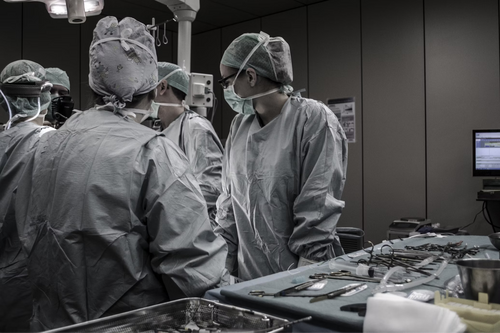
25 Oct Long-Term Outcomes For Patients With Spinal Stenosis
Spinal stenosis affects millions of people and its symptoms can range in severity, with some people not even knowing they have the condition. For people who experience symptoms, the good news is that there are a variety of treatment options available to help them return to a normal life.
This article will explore the long-term outcomes for patients with spinal stenosis, considering treatments such as physical therapy, medication, and exercise. In some cases, an individual may require surgery for severe spinal stenosis which will also be explained in this review.

Spinal Stenosis: A Quick Explanation
Spinal stenosis is caused when the spinal canal becomes too narrow and the spinal cord and nerves become impinged. This can result in pain and other symptoms that can harm a person’s quality of life, possibly affecting their social life and career. This condition is more common in older people and can be caused by general wear and tear in the spine, resulting in osteoarthritis, and deterioration of the vertebrae.
Spinal stenosis usually occurs in the neck and lower back but can develop at any level in the spine. It can also apply pressure to the sciatic nerve, causing sciatica which can contribute to other unwanted symptoms.
Symptoms linked to spinal stenosis often include:
- Varying degrees of pain
- A feeling of pins and needles in the lower body and upper legs
- Numbness in the buttocks and legs
- Cramping
- Weakness in the legs and feet
- Loss of bladder or bowel control
- Sexual dysfunction
How Can Spinal Stenosis Be Treated?
A doctor would typically recommend treatment in three tiers, the first focuses on exercise, improving mobility, and pain control, the second involves more targeted pain relief, and the third is surgery to provide a long-term cure.
Tier 1 Spinal Stenosis Treatments
Medication
The first step is usually pain control which often comes in the form of medication such as over-the-counter painkillers like ibuprofen or paracetamol, or as non-steroidal anti-inflammatory drugs (NSAIDs). More than one type of medication may be issued at any one time, providing more effective relief compared to relying on just one drug. NSAIDS may have significant side effects and should be used under your provider’s direction.
If a person is suffering from intense pain they may be prescribed stronger medication that targets the nerves like Amitriptyline.
Exercise
In addition to medication, a person suffering from spinal stenosis will also be encouraged to visit a physical therapist and to follow a routine of gentle exercise (walking or swimming) and healthier eating. The goal of physical therapy and exercise is to improve spinal strength, mobility, and flexibility, as well as promote better overall fitness. A stronger and healthier body is the best way to manage pain without medical assistance.
Being overweight applies extra pressure to the spine and can aggravate symptoms. Because of this, a person will be strongly advised to lose weight through exercise and by eating a healthier diet that includes food that is low in fat and sugar and has anti-inflammatory properties. Anti-inflammatory foods can include oily fish, berries, grains, leafy greens, nuts, avocado, and olives.

Tier 2 Spinal Stenosis Treatments
If pain symptoms do not subside following initial treatments then a stronger course of pain management may be required. This can come in the form of steroid-based pain-killing injections such as those administered epidurally. Epidurals are injected into the spinal canal and can treat the affected area quickly, however, studies show that epidural injections can be more effective at treating leg pain than back pain.
Alternatively, nerve block injections may be prescribed which can often have a permanent effect in alleviating symptoms and are considered a low-risk form of medication as they are minimally invasive. Nerve blocks can be injected in three key locations, the facet-joints, intercostally (the ribs), or epidurally (the spinal canal).
Tier 3 Spinal Stenosis Treatments (Surgery)
If tier 2 treatment proves unsuccessful and the pain has shown no improvement the the final option is surgery, although this measure will only be recommended once all other alternatives have been trialed. For spinal stenosis, the most common form of surgery is a laminectomy (decompression surgery) which involves removing part of the vertebrae, a small bone spur known as the lamina.
To ensure the spine is stable following a laminectomy, the procedure is often combined with a spinal fusion. This involves fusing two vertebrae using a bone graft and metal rods and screws to securely fix them in place and stabilize the affected area. The key drawback to this is that spinal fusion can reduce a person’s mobility, sometimes significantly, preventing them from freely performing normal actions like bending over.
An alternative to spinal fusion is to fit a mechanical spinal device that mimics the natural movement of the vertebrae and allows a person to retain full motion in their spine. These devices also have a quicker recovery time when compared to spinal fusion.
Spinal surgery may not be recommended if a person has poor overall fitness, underlying health concerns, or if spinal stenosis is present in multiple areas of the spine.
Long-Term Outcomes: Recovery From Spinal Stenosis Surgery
It can be difficult to offer a precise recovery time for spinal surgery as can differ from individual to individual, while timeframes can also vary depending on the type of surgery. Recovery times for a laminectomy, for example, are around 4-to-8 weeks before a person can return to work but this may be longer if a person works a manual job.
Spinal fusion on the other hand has a longer recovery time and if a person undergoes both a laminectomy and spinal fusion, the recovery time can be as long as 3-to-4 months.

To enable faster recovery time, surgery patients should try to move often but not overdo it, taking frequent, gentle walks and avoiding strenuous exercises that may cause damage. Patients should also stick to their recommended dosage of medication and take periods of rest if they are struggling with pain.
Thanks for reading. If you have spinal stenosis or are experiencing symptoms related to spinal stenosis please consult your health care provider. We hope this article has provided some helpful information on the possible treatment options.
For more information:
- https://www.niams.nih.gov/health-topics/spinal-stenosis
- https://www.webmd.com/back-pain/spinal-stenosis
———–
The information on MedicalResearch.com is provided for educational purposes only, and is in no way intended to diagnose, cure, or treat any medical or other condition.
Some links may be sponsored. Products, included compounded prescriptions above, are not warranted or endorsed.
Always seek the advice of your physician or other qualified health and ask your doctor any questions you may have regarding a medical condition. In addition to all other limitations and disclaimers in this agreement, service provider and its third party providers disclaim any liability or loss in connection with the content provided on this website.
Last Updated on October 25, 2024 by Marie Benz MD FAAD
